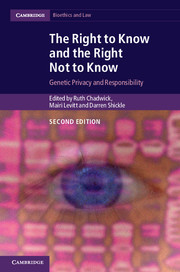Book contents
- Frontmatter
- Contents
- List of contributors
- Acknowledgements
- Introduction
- Part I Philosophical and legal issues
- Part II Issues in genetics
- 4 Biobanks and feedback
- 5 Suspects, victims and others: producing and sharing forensic genetic knowledge
- 6 Empowered by choice?
- 7 DIY genetics: the right to know your own genome
- 8 Genomics, inconvenient truths and accountability
- Part III Emerging issues
- Index
- References
5 - Suspects, victims and others: producing and sharing forensic genetic knowledge
Published online by Cambridge University Press: 05 September 2014
- Frontmatter
- Contents
- List of contributors
- Acknowledgements
- Introduction
- Part I Philosophical and legal issues
- Part II Issues in genetics
- 4 Biobanks and feedback
- 5 Suspects, victims and others: producing and sharing forensic genetic knowledge
- 6 Empowered by choice?
- 7 DIY genetics: the right to know your own genome
- 8 Genomics, inconvenient truths and accountability
- Part III Emerging issues
- Index
- References
Summary
Introduction
This chapter examines several related non-medical contexts in which genotyping is carried out and where questions arise over who has the right to commission, deploy and share with whom the results of that genotyping. There are three such contexts on which we focus attention. The first – and dominant one – is the application of genetic technologies to biological material recovered from crime scenes, from the victims of crime, from criminal suspects and from others for ‘elimination purposes’ in the course of criminal inquiries. The second is when genetic analysis is carried out on bodies recovered at ‘mass disasters’ in an effort to identify the dead. The third is the sampling and profiling of individuals involved in paternity and maternity disputes, or in other circumstances where it is deemed necessary to prove close genetic affiliation. We refer to all three of them as ‘forensic’ on the grounds that the primary purpose of each is to support legal process of various kinds, including the deliberations of civil, coronial, local, national and international criminal courts. Each genotyping knowledge context raises slightly different issues because of variations in the identities of the persons from whom samples are taken, the nature of the genetic information produced by preferred technologies, the primary purposes which its production serves and varying expectations of how much of this information should be shared with whom and under what circumstances.
A complicating factor is that close examination of some of these contexts suggests that the seemingly clear boundary between forensic genetic applications and the use of genetic knowledge within clinical medicine (or medical research) is often opaque in practice. This may be due to genetic inquiries crossing contexts of use (e.g., medical issues might be relevant for a criminal investigation or a paternity determination). It may be because medical information and genetic information have to be used in combination (e.g., to determine the robust identification of bodies), and it may also occur because some data generated by the application of particular genotyping methods are useful in both medical and non-medical contexts (e.g., analysis of ancestral lineage is relevant for biomedical research and for forensic identification).
- Type
- Chapter
- Information
- The Right to Know and the Right Not to KnowGenetic Privacy and Responsibility, pp. 70 - 84Publisher: Cambridge University PressPrint publication year: 2014
References
- 1
- Cited by



